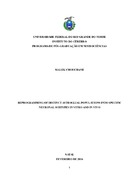Use este identificador para citar ou linkar para este item:
https://repositorio.ufrn.br/handle/123456789/21277| Título: | Reprogramming of distinct astroglial populations into specific neuronal subtypes in vitro and in vivo |
| Autor(es): | Chouchane, Malek |
| Orientador: | Costa, Marcos Romualdo |
| Palavras-chave: | Cell reprogramming;Cortical and cerebellar astroglia;Induced neurons;Cell tranplant;In vivo integration |
| Data do documento: | 29-Fev-2016 |
| Editor: | Universidade Federal do Rio Grande do Norte |
| Referência: | CHOUCHANE, Malek. Reprogramming of distinct astroglial populations into specific neuronal subtypes in vitro and in vivo. 2016. 150f. Tese (Doutorado em Neurociências) - Universidade Federal do Rio Grande do Norte, Universidade Federal do Rio Grande do Norte, Natal, 2016. |
| Resumo: | Recently, the field of cellular reprogramming has been revolutionized by works showing the potential to directly lineage-reprogram somatic cells into neurons upon overexpression of specific transcription factors. This technique offers a promising strategy to study the molecular mechanisms of neuronal specification, identify potential therapeutic targets for neurological diseases and eventually repair the central nervous system damaged by neurological conditions. Notably, studies with cortical astroglia revealed the high potential of these cells to reprogram into neurons using a single neuronal transcription factor. However, it remains unknown whether astroglia isolated from different regions of the central nervous system have the same neurogenic potential and generate induced neurons (iN) with similar phenotypes. Similarly, little is known about the fate that iNs could adopt after transplantation in the brain of host animals. In this study we compare the potential to reprogram astroglial cells isolated from the postnatal cerebral cortex and cerebellum into iNs both in vitro and in vivo using the proneural transcription factors Neurogenin-2 (Neurog2) and Achaete scute homolog-1 (Ascl1). Our results indicate cerebellar astroglia can be reprogrammed into induced neurons (iNs) with similar efficiencies to cerebral cortex astroglia. Notably however, while iNs in vitro adopt fates reminiscent of cortical or cerebellar neurons depending on the astroglial population used for reprogramming, in situ, after transplantation in the postnatal and adult mouse brain, iNs adopt fates compatible with the region of integration. Thus, our data suggest that the origin of the astroglial population used for lineage-reprogramming affects the fate of iNs in vitro, but this imprinting can be overridden by environmental cues after grafting. |
| URI: | https://repositorio.ufrn.br/jspui/handle/123456789/21277 |
| Aparece nas coleções: | PPGNEURO - Doutorado em Neurociências |
Arquivos associados a este item:
| Arquivo | Descrição | Tamanho | Formato | |
|---|---|---|---|---|
| MalekChouchane_TESE.pdf | 2,97 MB | Adobe PDF |  Visualizar/Abrir |
Os itens no repositório estão protegidos por copyright, com todos os direitos reservados, salvo quando é indicado o contrário.

